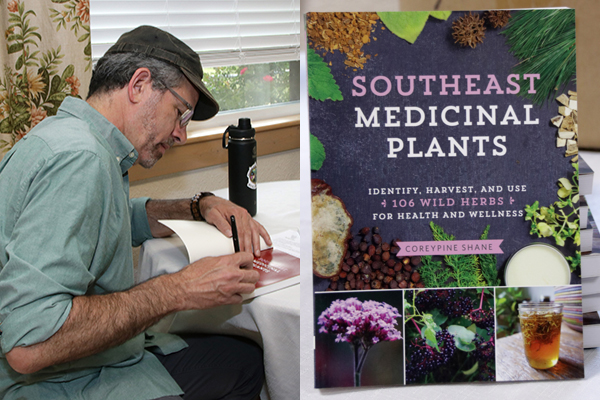By Ken Bridle
Identify, Harvest, and Use 106 Wild Herbs for Health and Wellness
A Review
This is a modern update into what your ancestors knew about many of our southeast plants.
The stated purpose of the North Carolina Native Plant Society is to promote the enjoyment and conservation of North Carolina’s native plants and their habitats through education, protection, cultivation, and advocacy. To most of us this means plants in their natural setting and plants in our gardens and public spaces. For most people this starts as an aesthetic appreciation of their beauty in woodland or meadow and in gardens. Later this may evolve into an ecological awareness of native plants as functional parts of the environment and necessary for the continued functioning of a healthy Mother Nature.
Plants that help us
As a society we have come to understand native plants as insect host plants, pollinator and nectar plants, seed sources for birds, nesting and cover for small animals and much more. However, as CoryPine Shane points out in his book, most of us have forgotten that humanity itself has a long history around the globe as part of a natural community dependent on native plants for food, fiber and medicine. All of us have ancestors who were indigenous people somewhere. Only in the past several generations have we lost the knowledge of how to use native plants as our herbal apothecary, to help our bodies, cure injury and disease and promote health and wellness.
Techniques for home use
As a Timber Press book, it is expected that the layout and photography would be top notch. However, this book has most of the basic things I like to see in all books: clear, concise and witty writing, nice organization and layout, very good photos, detailed index and a bibliography. Most of the photographs are by the author. After a few introductory chapters on identification and the processes of turning plants into medicine, the majority of the book is short descriptions of each plant and its uses arranged alphabetically by common name. This book keeps the “medicine making” simple, using techniques that most people can do at home without too much complicated or expensive equipment. Making teas, tinctures and infused oils as needed.
In the front of the book is important information on where and how to harvest, ethically and responsibly. Information for people who care about the sustainability of native plant populations is typically found in any herbal book dealing with wild crafting from collected material.
A step further
This book goes a step further by adding a “Future Harvests” paragraph to each plant section. Here are important details relating to harvests of that specific plant: if it’s common or an introduced weed, it says so. However, if it’s rare, slow growing, susceptible to over harvesting, or occurs in a sensitive habitat, the author recommends caution or no harvesting. Goldenseal and Ginseng are examples of plants that are not now recommended for harvest in the traditional manner. Alternatively, there are many plants like common goldenrods that are abundant or Japanese Barberry that are an invasive and can be harvested as long as the proper plant identification is made.
As with any pharmaceutical
There are also cautions listed for many of the plants that relate to their toxicity, potential allergy cause, inadvisability during pregnancy, sun sensitivity, and other issues that are good to know and help people realize this can be very serious stuff. Proper preparation and use is just as important with herbal products as it is with any pharmaceutical.
The common names used by herbalists are sometimes different from common names used by non-herbalists. However, the author does recommend and use the scientific names as determined by Alan Weakley, 2020 Flora of the Southeastern U.S. (University of North Carolina Press).
Reading this book will not make you a competent herbalist, but it will give you an insight into the properties of many common plants that are no longer obvious to us in the modern world. This is a window into what your great grandmother knew and an invitation to delve a little deeper into your partnership with many of the plants of the southeast.
Editor’s Note: CoreyPine Shane was guest lecturer at the 2022 Spring Hikes event sponsored by the NC Native Plant Society. See our other articles about the Spring Hikes, Botanizing with Friends in the Great Smoky Mountains and Did You Spot These Plants?
By Ken Bridle
Native Plant News – Fall 2022

Ken Bridle, Ph.D., is currently conservation advisor, Piedmont Land Conservancy where he has been active for nearly 30 years. In his professional career and on behalf of other organizations including the Nongame Wildlife Advisory Committee, his conservation research and restoration projects encompass watershed assessments, wetland delineations, and rare plant and animal surveys in North Carolina and the greater southeast. A frequent leader of hikes and nature walks and a speaker on local conservation issues, he is a past and current president of the North Carolina Native Plant Society.
Copyright © 2022 North Carolina Native Plant Society. All rights reserved.

